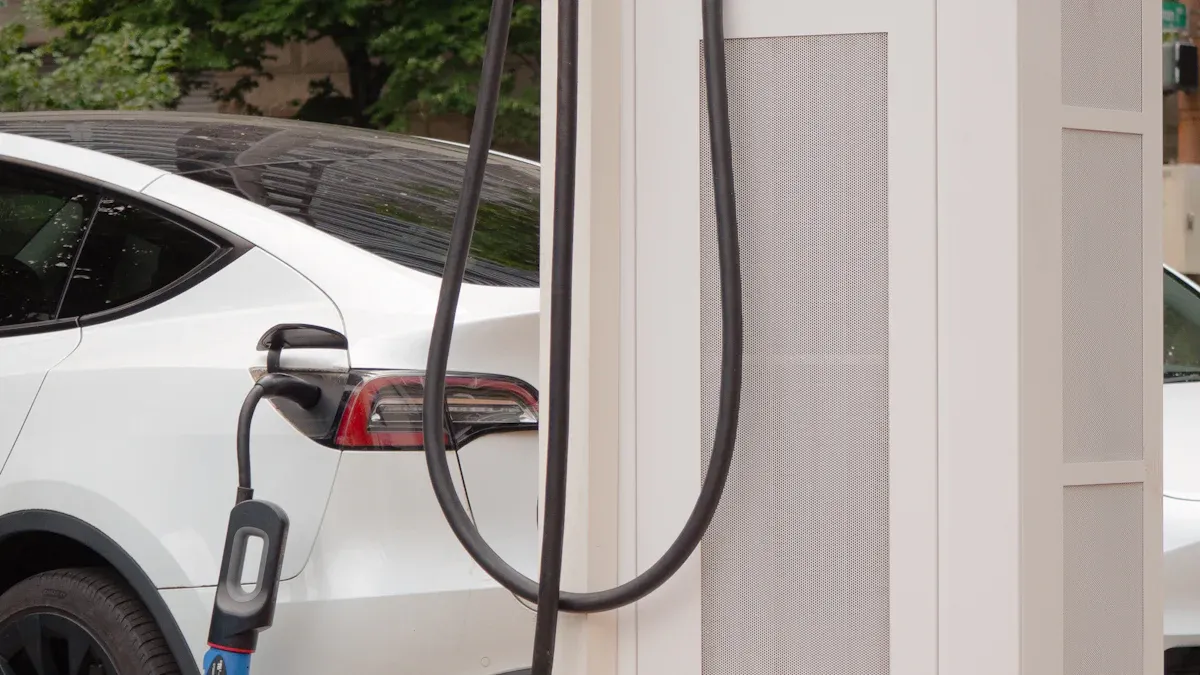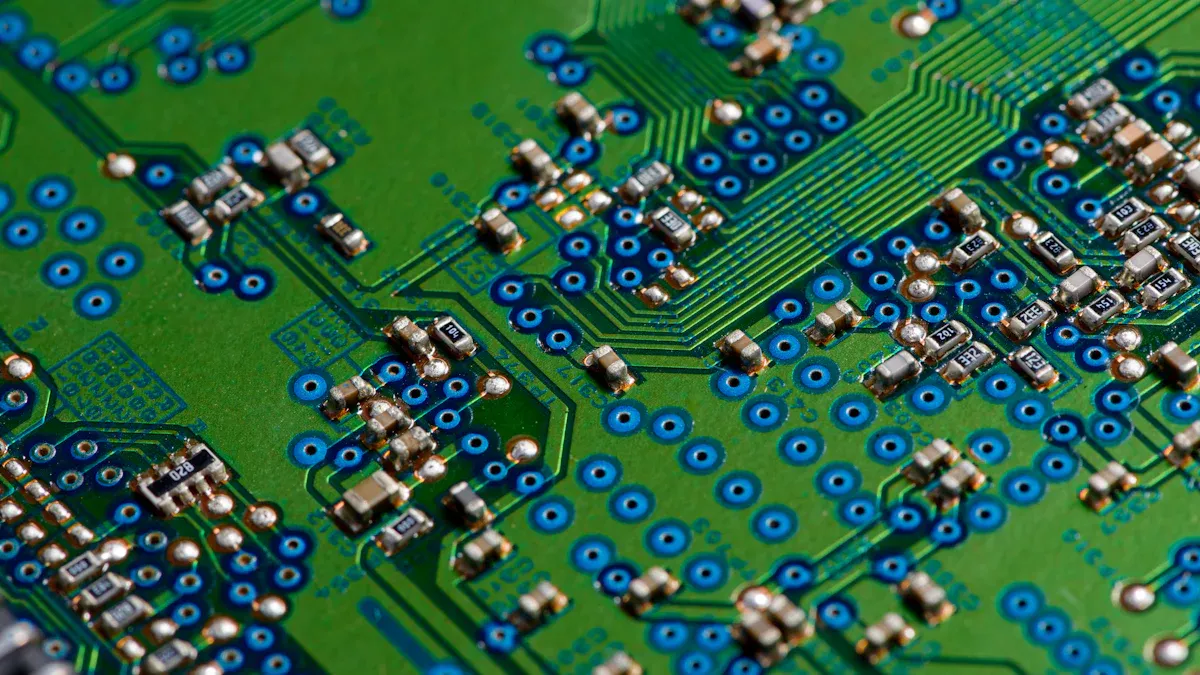
Improving PCBA for EV charging stations USA is crucial for creating a strong and efficient system for electric vehicles. These charging stations must support faster, safer, and smarter charging solutions. As the adoption of electric cars grows, PCBA for EV charging stations USA plays a vital role in managing essential components like batteries and power systems. With modern vehicles becoming increasingly complex, multi-layer PCBs are essential for ensuring safety and effective battery control. Enhancing PCBA for EV charging stations USA not only boosts the performance of these stations but also promotes sustainable and eco-friendly transportation.
Key Takeaways
Keep systems cool for better performance. Use liquid cooling and batteries that transfer heat well during heavy use.
Pick strong parts that last longer. Durable materials and good heat control tools help EV chargers work under stress.
Make smart PCB layouts. Plan circuits, safety tools, and heat control to boost reliability.
Ensure signals stay clear. Reduce signal noise and design traces well for smooth communication between parts.
Follow rules and get certifications. Meeting safety and performance standards builds trust and keeps chargers legal.
The Importance of PCBA for EV Charging Stations

Making Power Delivery Better
EV charging stations need good power flow to work well. PCBA helps control power and cuts down energy waste. Better designs allow faster charging and steady performance. Using copper-graphene materials helps remove heat quickly. This keeps the system cool and makes it work better during heavy use.
Keeping Systems Safe and Reliable
EV charging stations must be safe and dependable. A smart PCBA design stops failures and keeps things running smoothly. Safety tools like coatings and monitors protect the system from harm. These tools find problems like current leaks and activate safety measures. Strong insulation and safety rules make charging stations meet standards and work reliably.
Adding Smart Features and Connections
Modern EV stations use tech for easy charging. PCBA helps with wireless links, remote checks, and smart charging. Good PCB designs fit these features together for top performance. Strong signal setups reduce problems and improve connections. This lets EV users get live updates and enjoy smooth charging made just for them.
Strategies to Optimize PCBA for High Efficiency

Improving Thermal Management in High-Power Applications
Managing heat is key for EV charging systems to work well. High-power systems create a lot of heat, which can lower efficiency and damage parts. Using better cooling methods can solve this problem.
Liquid cooling works great for fast charging. It removes heat quickly and keeps the system steady during heavy use.
High-heat transfer (HHT) batteries cool faster than regular ones. They help with quicker charging and make the system last longer.
A study shows how micro-scale jet arrays help control heat. These jets, paired with special surfaces, handle high heat while keeping pressure low.
Study Details | Results |
|---|---|
Micro-scale jet arrays for cooling | Jets with special surfaces manage heat well and keep pressure low. |
Using these ideas helps EV chargers stay efficient even under tough conditions.
Selecting High-Quality Components for Durability
EV chargers need strong parts to handle stress and weather. Good materials make the system last longer and work better.
Mechanical stress from vibrations can harm PCBs. Strong materials and vibration tests make them tougher.
Heat dissipation is also important. Tools like heat sinks and pipes keep parts cool and stop overheating.
Choosing durable materials and cooling tools helps chargers survive daily use.
Designing Efficient PCB Layouts for EV Chargers
A good PCB layout makes EV chargers safe and reliable. Careful design improves how they work and last.
Feature | Purpose |
|---|---|
Circuit Design | Keeps charging safe and reliable with smart layouts. |
Safety Tools | Adds fuses and surge protectors for user safety and standards. |
Uses designs to manage heat and keep performance steady. | |
Signal Quality | Reduces noise for better data flow and connections. |
Focusing on these features boosts efficiency. For example, surge protectors meet safety rules. Heat control stops problems, and signal quality supports smart tech.
Using Strong Signal Practices
Good signal quality is key for EV chargers to work well. Bad signals can cause errors, failed communication, and poor performance. Focusing on signals helps chargers work better and stay efficient.
Steps to Keep Signals Strong
Lower Signal Noise
Noise can mess up how parts talk to each other. To fix this, use good grounding and shield important circuits. Adding small capacitors near power pins keeps voltage steady and stops interference.Improve Trace Design
PCB trace design affects signal quality a lot. Keep traces short and direct to lower resistance. Use special traces for fast signals to keep them clear. Pairing traces can also cut down on signal problems.Pick Good Materials
Materials matter for handling fast signals. Low-loss materials keep signals strong over time. Using materials with steady properties helps signals stay clear under stress.
Testing Signals for Better Performance
Testing checks if your PCBA works well in real life. Different tests find out how strong the signals are:
Test Type | Why It’s Done | What It Finds |
|---|---|---|
Checks how well the PCB handles electricity. | Finds heat issues and weak solder points. | |
Environmental Stress Test | Mimics real-life conditions for the PCB. | Shows how parts handle temperature changes. |
Burn-In Test | Runs PCBAs at high levels to find early problems. | Spots design or build flaws quickly. |
Accelerated Life Test (HALT) | Pushes designs to their limits to find weak spots. | Reveals design flaws and possible failures. |
These tests help catch problems early, keeping your PCBA reliable and efficient.
Tip: Check test results often to improve designs and fix weak spots. This saves time and money later.
By following these steps and testing well, your EV chargers will work smoothly and meet the needs of today’s electric cars.
Ensuring Compliance and Testing for PCBA
Following Industry Standards for EV Charging Stations
Meeting rules ensures EV chargers are safe and work well. These rules guide how circuits, batteries, and systems should perform. For PCBA, certifications like UL 2202 and UL 2594 focus on EV charging tools and systems. These prove your chargers meet safety and performance needs.
Certification | What It Covers |
|---|---|
UL 2202 | EV Charging System Equipment |
UL 2594 | EV Supply Equipment Standards |
Other certifications like ISO 9001 and IATF16949 ensure quality and reliability for cars. Green certifications like ISO 14001 and RoHS support eco-friendly practices. CE and UL confirm global safety compliance.
Certification | What It Covers |
|---|---|
IATF16949 | Car Quality Management |
ISO 9001 | General Quality Management |
ISO 14001 | Environmental Safety |
RoHS | Limits Harmful Substances |
By following these rules, you gain user trust and meet legal needs.
Testing for Function and Environment
Testing checks if PCBA works well in real-life situations. Functional tests see how circuits handle power, batteries, and safety. Environmental tests mimic tough conditions like heat and humidity to check durability.
For example, testing at 85% humidity shows how water affects materials. Results show 9.5% moisture absorption, which can lower insulation strength. Tests also measure how much stress the PCB can take without breaking.
Condition | Water Absorption (%) | Strength (N/mm²) | Modulus (N/mm²) | Break Stretch (%) |
|---|---|---|---|---|
85% RH | 9.5 | [value] | [value] | [value] |
50% RH | 4 | [value] | [value] | [value] |
Other tests like HALT push PCBA to its limits with fast temperature changes and vibrations. These tests make sure PCBA can handle EV charger demands.
Ensuring Safety and Trust Through Certification
Certifications prove PCBA is safe and reliable. High-voltage safety tools like coatings and monitors are key. Coatings keep insulation resistance above 10 GΩ during tough tests, like 85°C and 85% RH for 1,000 hours. Monitors find leaks under 0.1 mA and trigger safety actions when needed.
Better heat control also helps with certifications. Copper-graphene materials lower heat by 25°C, keeping parts cooler. These upgrades meet standards like IEC 60664-1 for strong insulation.
Certifications like UL and CE confirm PCBA safety and quality. Getting these shows you care about safety and making chargers work well.
Tip: Check certification updates often to stay current. This helps you follow rules and improve designs.
Working with Experts in PCBA for EV Charging Stations
Teaming Up with Skilled Manufacturers
Partnering with skilled manufacturers can make EV chargers better. These partnerships offer many benefits:
They improve customer support, helping from design to production.
Skilled manufacturers solve problems fast and give ongoing engineering help.
Local American PCB makers provide better quality, faster delivery, and strong IP protection.
By working with experienced manufacturers, you meet rules easily and improve reliability. This teamwork sparks new ideas, helping you create standout solutions.
Using Engineering Skills for Custom Designs
Expert engineers are key to improving PCBA for EV chargers. They help design custom solutions for your specific needs. Here are some helpful tips:
Use wider tracks and spacing to lower costs and improve results.
Work early with manufacturers to check designs and avoid extra features.
Pick parts with bigger sizes and standard options for easy sourcing.
These steps cut costs and make chargers last longer. Reliable suppliers also reduce defects and save money on repairs. With expert help, your wireless EV chargers will work smoothly.
Importance of Prototyping and Improving Designs
Prototyping is crucial for making reliable EV chargers. It lets you test and fix designs before full production. This saves time and money by finding problems early.
Improving designs step by step ensures better results. Each update uses feedback and tests to meet high standards. For example, testing prototypes in real conditions shows how they handle heat or wireless signals.
This method helps create fast chargers that meet user needs and rules. Prototyping also encourages teamwork, leading to creative solutions made just for you.
Tip: Write down what you learn during prototyping to make future projects easier and better.
Improving PCBA is key to making EV chargers better. Good PCB designs help electricity flow smoothly for faster charging. New PCB technology adds smart features, making chargers easier to use.
Working with skilled makers and engineers gives you top-quality results. Following rules and getting certifications keeps chargers safe and trusted. Using these ideas helps build chargers that handle more EVs while staying affordable and efficient.
Note: Better PCBA today means a greener and smarter EV charging future.
FAQ
What does PCBA do in EV charging stations?
PCBA works like the brain of EV chargers. It controls power flow, keeps things safe, and adds smart features like connections. A good PCBA makes charging faster and more reliable, which is important for today’s EV systems.
How can you make PCBA last longer in EV chargers?
You can make PCBA stronger by using top-quality parts and sturdy materials. Managing heat well and adding protective layers also help. Stress tests ensure the PCBA can handle tough conditions and daily use.
Why is managing heat important for EV chargers?
Heat control stops parts from getting too hot and breaking. Overheating can lower how well the charger works. Using tools like liquid cooling and heat sinks keeps the system cool and running smoothly.
What certifications should PCBA have for EV chargers?
PCBA needs to meet rules like UL 2202, UL 2594, and ISO 9001. These certifications prove the chargers are safe, high-quality, and eco-friendly. They also help you follow laws and earn customer trust.
How does prototyping help with PCBA design?
Prototyping lets you test and fix designs before making a lot of them. It finds problems early, saving time and money. Step-by-step improvements make sure the final PCBA is safe, efficient, and works well.
Tip: Write down what you learn during prototyping to make future designs better and easier to create.
See Also
Strategies to Enhance Workflow Efficiency in PCBA Production
Best Practices for Maintaining Quality and Efficiency in PCBA
Ten Pro Tips for Cost-Effective and Efficient PCBA Assembly